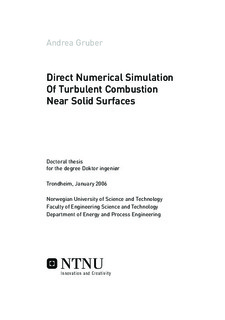| dc.contributor.author | Gruber, Andrea | nb_NO |
| dc.date.accessioned | 2014-12-19T11:44:02Z | |
| dc.date.available | 2014-12-19T11:44:02Z | |
| dc.date.created | 2010-04-20 | nb_NO |
| dc.date.issued | 2006 | nb_NO |
| dc.identifier | 311180 | nb_NO |
| dc.identifier.isbn | 82-471-7767-6 (printed version) | nb_NO |
| dc.identifier.isbn | 82-471-7766-8 (electronic version) | nb_NO |
| dc.identifier.uri | http://hdl.handle.net/11250/233475 | |
| dc.description.abstract | This study uses Direct Numerical Simulation of turbulent reacting compressible plane channel flow at low Reynolds number in order to understand the physics of the interaction of a flame with the turbulent boundary layer near a solid inert surface.
Better insight into the process of flame quenching near a solid surface, of the influence of turbulence on this process, and of its relation to the maximum and average wall heat fluxes, pollutant formation and incomplete fuel consumption is crucial to obtain improved prediction capabilities about combustor lifetime and pollutant emissions in complex engineering problems both at low Reynolds numbers (micro and nano gas turbines) and high Reynolds numbers (conventional gas turbines, internal combustion engines).
A fuel-rich mixture (characterized by an equivalence ratio of 1.5) of hydrogen and air is chosen for the direct simulations resulting in high turbulent flame speed, thereby allowing high centerline average fluid velocity which in turn results in relatively short channel transit times. Because of the high centerline average flow velocity the flame is anchored at the channel centerline and assumes a characteristic Vshape. The detailed chemical kinetics mechanism describing hydrogen combustion in air (NOx formation reactions are neglected) is relatively "light" from the computational point of view. Additionally, the possibility of using hydrogen as fuel in conventional combustion equipment has been under investigation in late years and this study hopes to contribute to the amount of knowledge available about (premixed) hydrogenflames behaviour.
As a first step the near-wall behaviour of a planar pre-mixed laminar flame is examined in a one-dimensional head-on quenching (HOQ) setup: very useful information is obtained about the impact of the physiochemical assumptions used to model the combustion process on the flame-wall interaction. A detailed chemical kinetics mechanism is adopted because it is well known from the literature that one-step simplified chemistry is not able to accurately capture the spatial nor the temporal evolution of the quenching process that takes place when the flame approaches the solid "cold" surface. The results compare well with the existing literature on planar onedimensional laminar flamewall interaction.
As a second step, the nearwall behaviour of the anchored v-shaped turbulent flame is studied both in two-and three-dimensional turbulent plane channel flow providing detailed insight of the side wall quenching (SWQ) configuration. Large differences in 2-D versus 3-D boundary layer turbulence characteristics, especially important at the wall, lead to large differences in nearwall flame behaviour and maximum wall heat fluxes for the two configurations: intense nearwall streamwise vorticity present in the 3D simulation "pushes" the flame closer to the wall increasing the maximum wall heat flux by a factor of two in respect to the 2D simulation. The average spatial spacing in the spanwise direction of the maximum wall heat flux "hotspots" is found to be close to 100 wall units while their characteristic temporal frequency is close to time scales between 10 and 30 wall or "inner" time units. The above mentioned spatial and temporal scalings correlate well with the mean spanwise spacing of the nearwall streamwise vorticity structures and with their characteristic longitudinal time scale. Threedimensional direct simulations are very expensive computationally and, at the time of the writing of this document, the computation is still running. Only few channel transit times are considered in the statistical analysis included in this report, statistical data from a larger number of samples will be reported in a later publication. | nb_NO |
| dc.language | eng | nb_NO |
| dc.publisher | Norges teknisk-naturvitenskapelige universitet, Fakultet for ingeniørvitenskap og teknologi, Institutt for energi- og prosessteknikk | nb_NO |
| dc.relation.ispartofseries | Doktoravhandlinger ved NTNU, 1503-8181; 2006:14 | nb_NO |
| dc.title | Direct Numerical Simulation Of Turbulent Combustion Near Solid Surfaces | nb_NO |
| dc.type | Doctoral thesis | nb_NO |
| dc.contributor.department | Norges teknisk-naturvitenskapelige universitet, Fakultet for ingeniørvitenskap og teknologi, Institutt for energi- og prosessteknikk | nb_NO |
| dc.description.degree | dr.ing. | nb_NO |
| dc.description.degree | dr.ing. | en_GB |
